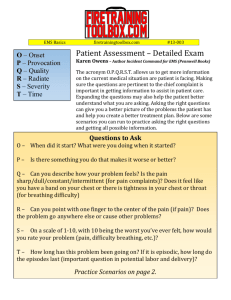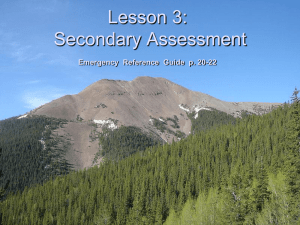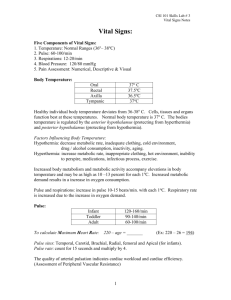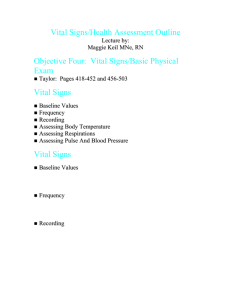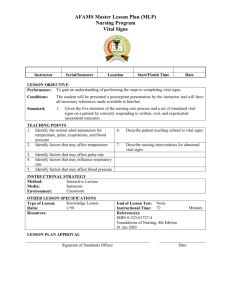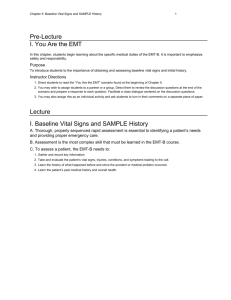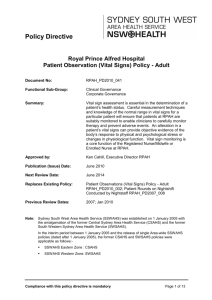Vital Signs Assessment
advertisement
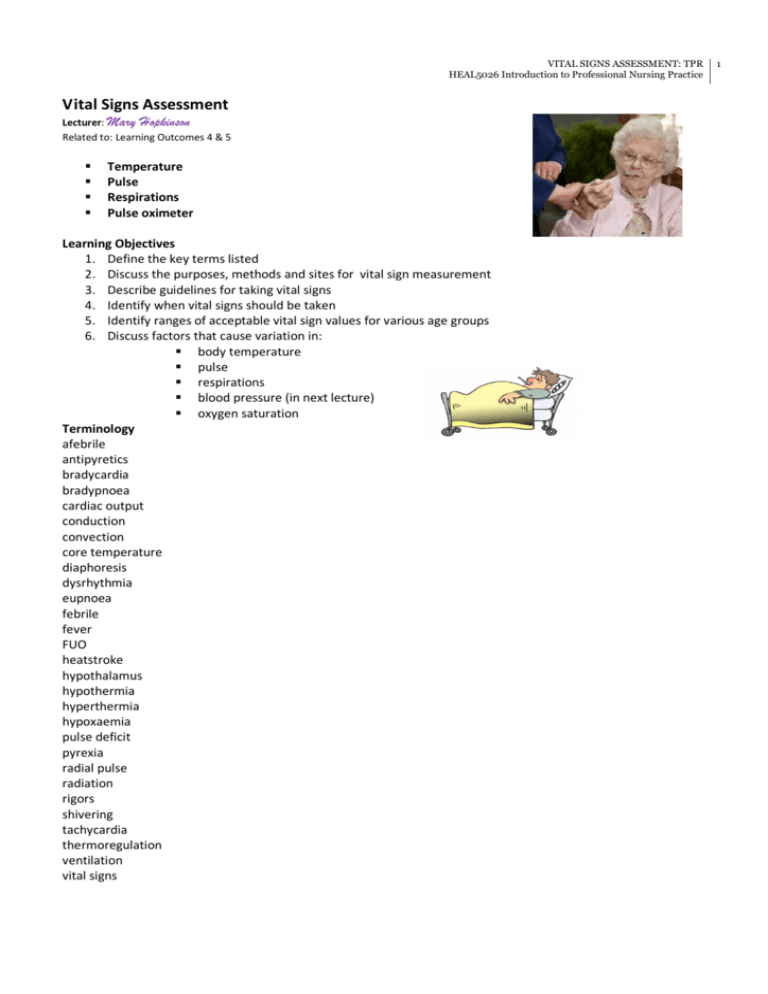
VITAL SIGNS ASSESSMENT: TPR HEAL5026 Introduction to Professional Nursing Practice Vital Signs Assessment Lecturer: Mary Hopkinson Related to: Learning Outcomes 4 & 5 Temperature Pulse Respirations Pulse oximeter Learning Objectives 1. Define the key terms listed 2. Discuss the purposes, methods and sites for vital sign measurement 3. Describe guidelines for taking vital signs 4. Identify when vital signs should be taken 5. Identify ranges of acceptable vital sign values for various age groups 6. Discuss factors that cause variation in: body temperature pulse respirations blood pressure (in next lecture) oxygen saturation Terminology afebrile antipyretics bradycardia bradypnoea cardiac output conduction convection core temperature diaphoresis dysrhythmia eupnoea febrile fever FUO heatstroke hypothalamus hypothermia hyperthermia hypoxaemia pulse deficit pyrexia radial pulse radiation rigors shivering tachycardia thermoregulation ventilation vital signs 1 VITAL SIGNS ASSESSMENT: TPR HEAL5026 Introduction to Professional Nursing Practice BODY TEMPERATURE Purposes, Methods and Sites “hotness” or “coldness” of a substance.” (Crisp & Taylor, 2009, p.546). heat produced – heat lost = body temperature thermoregulation: the balance between heat lost and heat produced hypothalamus maintains core temperature PURPOSES WHY take temperature measurements? To determine: basal metabolic rate potential presence of infection metabolic response to exercise Skin temperature circulatory status local inflammatory responses potential periphery nerve injury METHODS WHAT to use to take temperature measurements? Thermometers electronic tympanic mercury skin SITES WHERE to take temperature measurements? Surface: oral axillary rectal skin Core: 1. tympanic membrane 2. intensive care settings: pulmonary artery oesophagus urinary bladder Average optimal temperature for an adult: 36° C - 38° C 2 VITAL SIGNS ASSESSMENT: TPR HEAL5026 Introduction to Professional Nursing Practice PULSE (HEART RATE) Purposes, Methods and Sites pulse: measurement of heart rate (beats per minute) basal rate: pulse rate after an extended period of rest resting heart rate: pulse rate without imposed stress PURPOSES Why take pulse measurements? To determine: patency rate rhythm strength (amplitude) equality METHODS WHAT to use to take pulse measurements? manual palpation auscultation doppler pulse oximeter SITES WHERE to take pulse measurements? temporal: over temporal bone of head carotid: along medial edge of sternocleidomastoid muscle in neck apical: 4th to 5th intercostal space at left midclavicular line brachial: groove between biceps and triceps muscles at antecubital fossa radial: radial or thumb side of forearm at wrist ulnar: ulnar side of forearm at wrist femoral: below inguinal ligament, midway between symphysis pubis and anterior superior iliac spine popliteal: behind knees in popliteal fossa posterior tibial: inner side of ankle, below medial malleolus dorsalis pedis: along top of foot, between extension tendons of great and first toe Reference: Crisp & Taylor, 2009, p. 56. 3 VITAL SIGNS ASSESSMENT: TPR HEAL5026 Introduction to Professional Nursing Practice Acceptable ranges of heart rate (beats per minute) AGE HEART RATE Infants 120-160/min Toddlers 90-140/min Preschoolers 80-110/min School-agers 75-100/min Adolescents 60-90/min Adults 60-100/min Reference: Crisp & Taylor, 2009, p. 566. RESPIRATIONS Ventilation: ‘breathing cycle’ Purposes, Methods and Sites PURPOSES Why take respiration measurements? Rate of respirations (breathing) can be measured Each respiratory cycle is one inspiration and the subsequent expiration Quality of respirations can be observed METHODS WHAT to use to take respiratory measurements? • observation • watch with second hand for 1 full minute Acceptable range of respiratory rates for age AGE RESPIRATORY RATE Newborn (3000 g) 30-60 Infant (6 months) 30-50 Toddler (2 years) 25-32 Child 20-30 Adolescent 16-19 Adult 12-20 4 VITAL SIGNS ASSESSMENT: TPR HEAL5026 Introduction to Professional Nursing Practice Guidelines for taking vital signs Knowledge medical history pattern trend therapies prescribed medications Responsibility analysis interpretation formulating interventions Delegation assistive personnel Equipment functional and appropriate Frequency collaboration with medical team nurse judgement Approaching the patient calm and proficient Systematic approach environmental factors organised Communicating findings verification documentation patient education When to take vital signs? On admission Routine schedule Before and after: surgery or invasive diagnostic procedure, nursing interventions influencing a vital sign Before, during and after administration of medication: cardiovascular, respiratory, temperature-control function Change in physical condition Non-specific symptoms Factors affecting body temperature age exercise hormone level circadian rhythm stress environment temperature alterations -pyrexia -pyrogens -rigors -febrile -afebrile 5 VITAL SIGNS ASSESSMENT: TPR HEAL5026 Introduction to Professional Nursing Practice Factors affecting heart rate age exercise emotions drugs haemorrhage postural changes pulmonary conditions Factors affecting character of respirations exercise acute pain anxiety smoking body position medications neurological injury haemoglobin function References Ackley, B. J., Swan, B. A., Ladwig, G. B., & Tucker, S. J. (2008). Evidence-based nursing care guidelines: MedicalSurgical interventions. St. Louis: Elsevier. Retrieved February 11, 2008, from http://www.nursingconsult.com/das/book/119817642-4/view/1815 Crisp, J., & Taylor, C. (3rd. ed.). (2009). Potter and Perry’s fundamentals of nursing. Chatswood: Elsevier. 6

